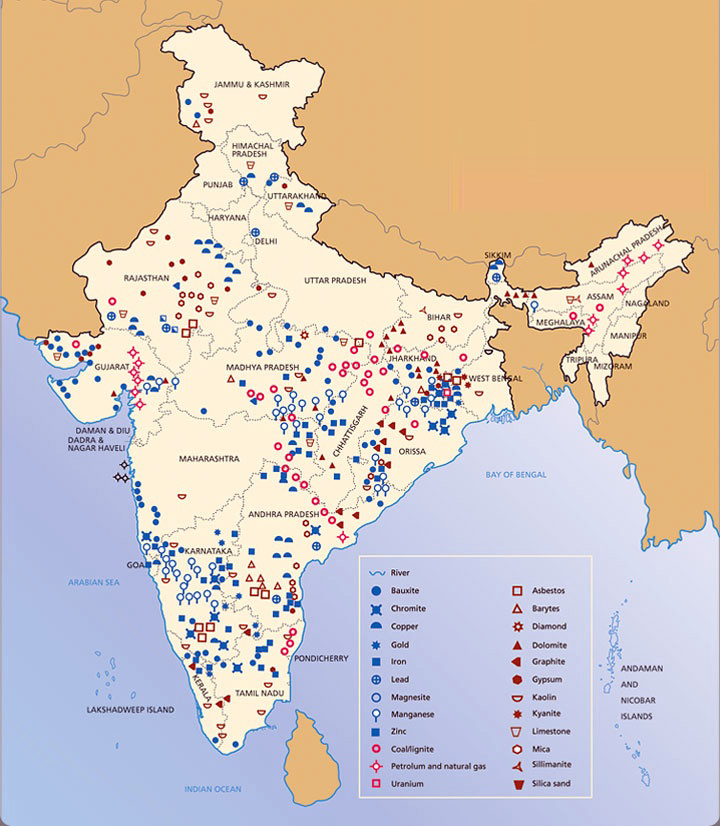Governance
Amendment to Minerals Rules
- 20 Dec 2021
- 6 min read
For Prelims: Features of Minerals (Evidence of Mineral Contents) Rules, 2015 and Mineral (Auction) Fourth Amendment Rules, 2021, The National Mineral Policy 2019, Minerals in India.
For Mains: Mining sector of India, Mineral Distribution in India, Amendment to Minerals Rules and its significance.
Why in News
Recently, the Minerals (Evidence of Mineral Contents) Second Amendment Rules, 2021 and the Mineral (Auction) Fourth Amendment Rules, 2021 have been notified.
- These two rules will amend the Minerals (Evidence of Mineral Contents) Rules, 2015 [MEMC Rules] and the Mineral (Auction) Rules, 2015 [Auction Rules], respectively.
- Earlier, Lok Sabha and Rajya Sabha both cleared the Mines and Minerals (Development and Regulation) (MMDR) Amendment Bill, 2021.
Minerals (Evidence of Mineral Contents) Rules, 2015
- It have been recently amended in June, 2021, inter alia, to provide for auction to grant a composite licence in respect of areas where at least Reconnaissance Survey (G4) level has been completed or where mineral potentiality of the block has been identified based on the available geoscience data but resources are yet to be established.
- A Reconnaissance Survey provides a snapshot of potential historic resources in a particular location at a specific point in time.
- These amendments were aimed at identifying more mineral blocks for auction and thereby increasing the pace of exploration and production resulting in improving the availability of minerals in the country and increasing employment in the sector.
Mineral (Auction) Rules, 2015
- It was amended, inter alia, to prescribe bid security, performance security and other eligibility conditions to enable auction of such blocks for composite licence.
- Geological Survey of India (GSI) has also made available the database of baseline geoscience data for geological potential areas in the Online Core Business Integrated System Project (OCBIS) portal for assistance of prospective bidders and other stakeholders.
Key Points
- Minerals (Evidence of Mineral Contents) Second Amendment Rules, 2021:
- It will enable any person (who is intending to participate in auction) to propose suitable blocks for auction for composite licence where mineral potentiality of the blocks has been identified based on the available geoscience data.
- A committee constituted by the State Government shall assess the mineral potentiality of the blocks so proposed and recommend the block for auction.
- Mineral (Auction) Fourth Amendment Rules, 2021:
- It would provide that in case the blocks proposed by any person are notified for auction, the said person would be provided incentive of depositing only half of the bid security amount in auction of the blocks proposed by him.
- Part surrender of mining lease area has been allowed in all cases.
- Till now, part surrender was allowed only in case of non-grant of forest clearance.
- Provisions have also been added to allow disposal of overburden/ waste rock/ mineral below the threshold value, which is generated during the course of mining or beneficiation of the mineral.
- Minimum area for grant of mining lease has been revised from 5 ha. (hectares) to 4 ha. For certain specific deposits, minimum 2 ha. is provided.
- Aim:
- To identify more mineral blocks for auction and thereby increase the pace of exploration and production resulting in improving the availability of minerals in the country,
- Significance:
- It will encourage more participation in auctions and promote competition.
- It will facilitate State governments in identifying more blocks for auction of composite licence.
- Initiatives Related to Mining:
- The National Mineral Policy 2019
- Initiatives are being taken to ensure early operationalisation of auctioned greenfield mineral blocks.
- Rationalisation of taxes in the mining sector is also being considered.
- Under the Atmanirbhar Bharat scheme, enhancing private investments in the mineral sector and bringing in other reforms has been announced.
- District Mineral Foundation Funds
Minerals in India
- India is richly endowed with mineral resources. Explorations have found over 20,000 known mineral deposits and recoverable reserves of more than 60 minerals.
- 11 states account for 90% of the total number of operational mines (Andhra Pradesh, Odisha, Chhattisgarh, Jharkhand, West Bengal, Maharashtra, Tamil Nadu, Gujarat, Madhya Pradesh, Rajasthan, and Karnataka).
- Globally, India is ranked as one of the leading producers of valuable minerals such as chromite, iron ore, coal and bauxite.
- The total geographical area of India is around 328 million hectares out of which mining lease (other than fuel, atomic and minor minerals) constitutes around 0.14%, barely 20% of it is mined.
- The Indian subsoils are rich in onshore and offshore crude oil and gas, coal, iron ore, copper, bauxite, etc.
- India produces as many as 95 minerals, which includes 4 fuel, 10 metallic, 23 non-metallic, 3 atomic and 55 minor minerals (including building and other materials).







